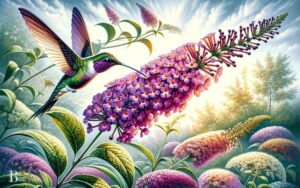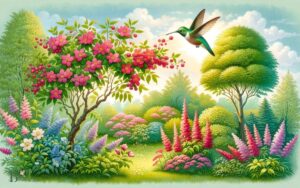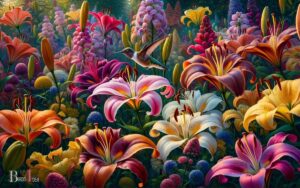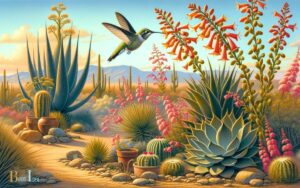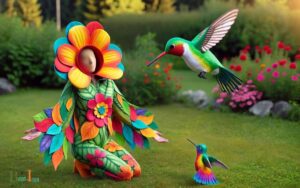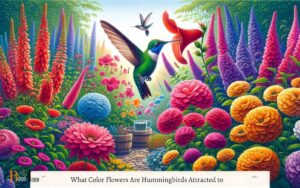Does Russian Sage Attract Hummingbirds: Yes!
Yes, Russian sage (Perovskia atriplicifolia) can attract hummingbirds. The plant features long spikes of purple-blue flowers that bloom throughout the summer and into the fall, which are known to draw the attention of hummingbirds.
Russian sage is a popular perennial plant that is not only admired for its aesthetic appeal but also for its ability to attract wildlife.
With its tall, waving wands of lavender or blue flowers and silvery foliage, Russian sage provides visual interest as well as:
Hummingbirds are particularly drawn to tubular flowers that are rich in nectar. Russian sage’s blooms fit this profile, making them an attractive food source for these small, energetic birds.
Russian sage’s vibrant blooms and resilience make it a favored choice for gardeners looking to create a hummingbird-friendly landscape.
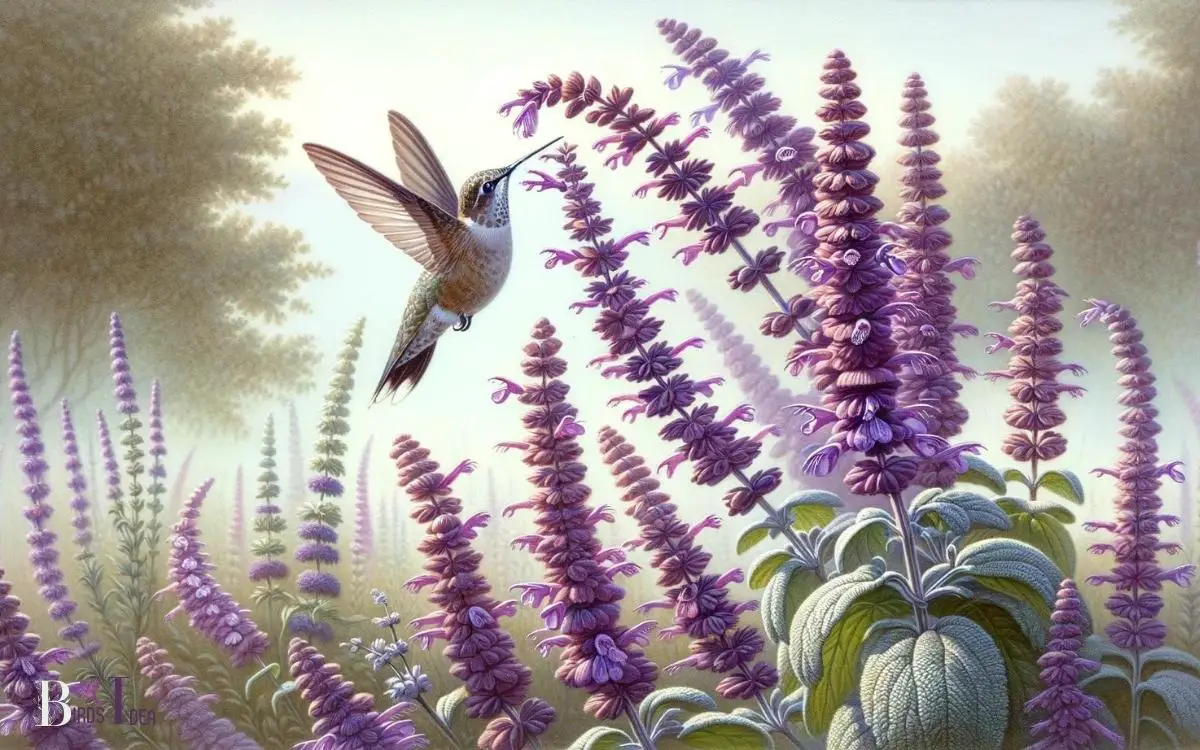
Key Takeaway
Russian Sage: A Hummingbird Favorite
Russian Sage is a favorite among hummingbirds. The long, elegant stems of this perennial plant produce tiny, bluish-purple flowers that are rich in nectar, attracting hummingbirds with their sweet scent and vibrant color.
These qualities make Russian Sage a popular choice for gardeners looking to create a hummingbird-friendly environment. Its ability to thrive in various climates and soil conditions further adds to its appeal.
When considering plants for a hummingbird garden, Russian Sage is often recommended due to its low maintenance and drought tolerance.
Its feathery foliage also provides a beautiful backdrop for the garden, adding to its overall charm.
With its ability to attract these delightful birds, it’s no wonder that Russian Sage is a top pick for many gardening enthusiasts.
Factors to Consider for Attracting Hummingbirds
Attracting hummingbirds to your garden requires careful consideration of the plants and features that provide the necessary sustenance and habitat for these captivating birds.
To attract hummingbirds, consider the following:
- Plant nectar-producing flowers such as trumpet vine, bee balm, and salvia to provide a natural food source for hummingbirds.
- Incorporate a water feature like a birdbath or mister to provide drinking and bathing opportunities for hummingbirds.
- Hang bright red or orange feeders in your garden to supplement natural nectar sources and attract hummingbirds with their vibrant colors.
Creating a welcoming environment with these elements will entice hummingbirds to visit and linger in your garden. This sets the stage for understanding the role of Russian sage in hummingbird gardens.
Characteristics of Russian Sage
One might appreciate the feathery foliage and drought tolerance of Russian Sage as notable characteristics that make it an attractive choice for gardeners.
Its silvery-gray leaves have a delicate, lacy appearance, adding texture and visual interest to gardens.
Russian Sage is also known for its ability to thrive in dry, arid conditions, making it a low-maintenance plant once established.
Its long-blooming period, typically from midsummer to early fall, showcases tiny, tubular, lavender-blue flowers that attract pollinators.
This perennial herbaceous plant can grow to a height of 3-5 feet and a spread of 2-4 feet, creating an airy, upright presence in the garden.
Russian Sage’s adaptability to various soil types and its resistance to pests and diseases further enhance its appeal to gardeners seeking an easy-care, yet visually striking, plant for their landscape.
Hummingbird Attraction to Russian Sage
Russian Sage can attract hummingbirds due to its tubular, nectar-rich flowers and extended blooming period.
Hummingbirds are drawn to the tubular shape of Russian Sage flowers, which allows them to easily access the nectar with their long, specialized bills.
The nectar produced by Russian Sage is a high-energy food source that provides the necessary sustenance for hummingbirds.
Additionally, the extended blooming period of Russian Sage, which can last from mid-summer to early fall, provides a consistent nectar source for hummingbirds throughout their active feeding season.
These factors make Russian Sage an attractive option for gardeners looking to create a hummingbird-friendly environment.
Understanding the factors that make Russian Sage appealing to hummingbirds can help in creating a garden that is welcoming to these delightful creatures.
Tips for Attracting Hummingbirds with Russian Sage
Attracting hummingbirds with Russian Sage can be a rewarding and beautiful addition to your garden.
Here are tips covering planting considerations, companion planting strategies, and maintenance practices to optimize the attraction of hummingbirds:
Planting Considerations:
Location:
- Choose a sunny location for planting Russian Sage, as it thrives in full sunlight.
- Ensure the soil is well-draining, as Russian Sage prefers dry to medium-moisture conditions.
Spacing:
- Plant Russian Sage with adequate spacing to allow good air circulation, preventing diseases.
- Space the plants at least 2 to 3 feet apart to accommodate their mature size.
Soil Preparation:
- Prior to planting, amend the soil with organic matter to improve fertility and drainage.
- Russian Sage is adaptable to various soil types, but it generally prefers slightly alkaline conditions.
Companion Planting Strategies:
Colorful Companions:
- Plant Russian Sage alongside other flowers that are rich in red, orange, or pink colors, as hummingbirds are attracted to these hues.
- Consider companion plants such as bee balm, salvia, and penstemon for a vibrant and hummingbird-friendly garden.
Varied Bloom Times:
- Include plants with staggered blooming periods to provide a continuous nectar source for hummingbirds throughout the growing season.
- Complement Russian Sage with early, mid, and late-blooming flowers to maintain hummingbird interest.
Tall and Short Combinations:
- Plant shorter flowers in front of Russian Sage to create a layered effect, allowing hummingbirds to easily access the nectar-rich blossoms.
- Good companion plants include low-growing sedums, petunias, or alyssum.
Maintenance Practices for Optimal Attraction:
Pruning:
- Prune Russian Sage in early spring to encourage bushier growth and more prolific flowering.
- Remove dead or spent flower spikes regularly to stimulate new blooms and maintain a tidy appearance.
Watering:
- While Russian Sage is drought-tolerant, regular watering during dry spells helps maintain its vitality and encourages more blooms.
- Avoid overwatering, as this plant prefers slightly dry conditions.
Fertilization:
- Use a balanced, slow-release fertilizer in spring to provide essential nutrients for healthy growth and blooming.
- Avoid excessive nitrogen, as it can result in lush foliage but fewer flowers.
Mulching:
Apply a layer of mulch around the base of Russian Sage to conserve soil moisture, suppress weeds, and moderate soil temperature.
By incorporating these tips into your gardening routine, you can create an inviting environment for hummingbirds while enjoying the beauty of Russian Sage and its companion plants.
Conclusion
Russian sage is a favorite of hummingbirds due to its vibrant flowers and sweet nectar. With its tall, airy stems and silvery foliage, it provides a beautiful backdrop for any garden.
To attract hummingbirds, plant Russian sage in a sunny location with well-drained soil and watch as these delightful creatures flock to it.
As the saying goes, “If you plant it, they will come.” So why not add some Russian sage to your garden and enjoy the sight of hummingbirds in action?

